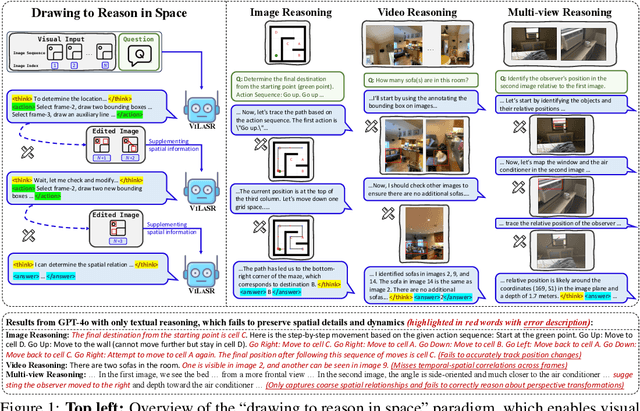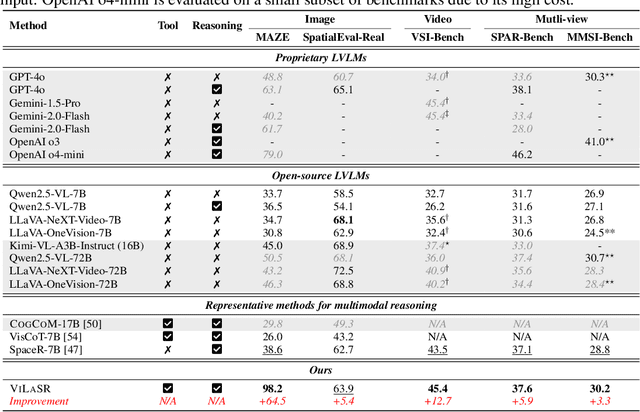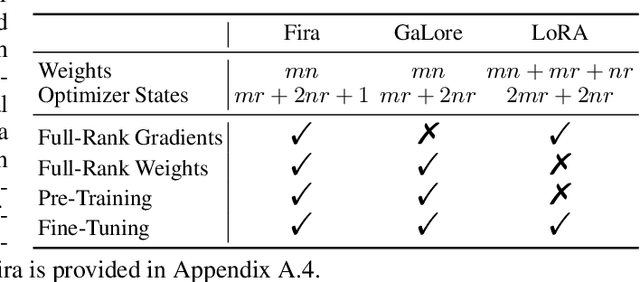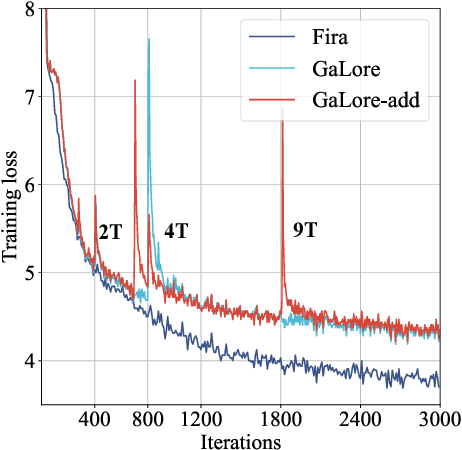Kaituo Feng
AdaTooler-V: Adaptive Tool-Use for Images and Videos
Dec 19, 2025Abstract:Recent advances have shown that multimodal large language models (MLLMs) benefit from multimodal interleaved chain-of-thought (CoT) with vision tool interactions. However, existing open-source models often exhibit blind tool-use reasoning patterns, invoking vision tools even when they are unnecessary, which significantly increases inference overhead and degrades model performance. To this end, we propose AdaTooler-V, an MLLM that performs adaptive tool-use by determining whether a visual problem truly requires tools. First, we introduce AT-GRPO, a reinforcement learning algorithm that adaptively adjusts reward scales based on the Tool Benefit Score of each sample, encouraging the model to invoke tools only when they provide genuine improvements. Moreover, we construct two datasets to support training: AdaTooler-V-CoT-100k for SFT cold start and AdaTooler-V-300k for RL with verifiable rewards across single-image, multi-image, and video data. Experiments across twelve benchmarks demonstrate the strong reasoning capability of AdaTooler-V, outperforming existing methods in diverse visual reasoning tasks. Notably, AdaTooler-V-7B achieves an accuracy of 89.8\% on the high-resolution benchmark V*, surpassing the commercial proprietary model GPT-4o and Gemini 1.5 Pro. All code, models, and data are released.
SpaceVista: All-Scale Visual Spatial Reasoning from mm to km
Oct 10, 2025Abstract:With the current surge in spatial reasoning explorations, researchers have made significant progress in understanding indoor scenes, but still struggle with diverse applications such as robotics and autonomous driving. This paper aims to advance all-scale spatial reasoning across diverse scenarios by tackling two key challenges: 1) the heavy reliance on indoor 3D scans and labor-intensive manual annotations for dataset curation; 2) the absence of effective all-scale scene modeling, which often leads to overfitting to individual scenes. In this paper, we introduce a holistic solution that integrates a structured spatial reasoning knowledge system, scale-aware modeling, and a progressive training paradigm, as the first attempt to broaden the all-scale spatial intelligence of MLLMs to the best of our knowledge. Using a task-specific, specialist-driven automated pipeline, we curate over 38K video scenes across 5 spatial scales to create SpaceVista-1M, a dataset comprising approximately 1M spatial QA pairs spanning 19 diverse task types. While specialist models can inject useful domain knowledge, they are not reliable for evaluation. We then build an all-scale benchmark with precise annotations by manually recording, retrieving, and assembling video-based data. However, naive training with SpaceVista-1M often yields suboptimal results due to the potential knowledge conflict. Accordingly, we introduce SpaceVista-7B, a spatial reasoning model that accepts dense inputs beyond semantics and uses scale as an anchor for scale-aware experts and progressive rewards. Finally, extensive evaluations across 5 benchmarks, including our SpaceVista-Bench, demonstrate competitive performance, showcasing strong generalization across all scales and scenarios. Our dataset, model, and benchmark will be released on https://peiwensun2000.github.io/mm2km .
Reinforcing Spatial Reasoning in Vision-Language Models with Interwoven Thinking and Visual Drawing
Jun 11, 2025



Abstract:As textual reasoning with large language models (LLMs) has advanced significantly, there has been growing interest in enhancing the multimodal reasoning capabilities of large vision-language models (LVLMs). However, existing methods primarily approach multimodal reasoning in a straightforward, text-centric manner, where both reasoning and answer derivation are conducted purely through text, with the only difference being the presence of multimodal input. As a result, these methods often encounter fundamental limitations in spatial reasoning tasks that demand precise geometric understanding and continuous spatial tracking-capabilities that humans achieve through mental visualization and manipulation. To address the limitations, we propose drawing to reason in space, a novel paradigm that enables LVLMs to reason through elementary drawing operations in the visual space. By equipping models with basic drawing operations, including annotating bounding boxes and drawing auxiliary lines, we empower them to express and analyze spatial relationships through direct visual manipulation, meanwhile avoiding the performance ceiling imposed by specialized perception tools in previous tool-integrated reasoning approaches. To cultivate this capability, we develop a three-stage training framework: cold-start training with synthetic data to establish basic drawing abilities, reflective rejection sampling to enhance self-reflection behaviors, and reinforcement learning to directly optimize for target rewards. Extensive experiments demonstrate that our model, named VILASR, consistently outperforms existing methods across diverse spatial reasoning benchmarks, involving maze navigation, static spatial reasoning, video-based reasoning, and multi-view-based reasoning tasks, with an average improvement of 18.4%.
MME-Reasoning: A Comprehensive Benchmark for Logical Reasoning in MLLMs
May 27, 2025Abstract:Logical reasoning is a fundamental aspect of human intelligence and an essential capability for multimodal large language models (MLLMs). Despite the significant advancement in multimodal reasoning, existing benchmarks fail to comprehensively evaluate their reasoning abilities due to the lack of explicit categorization for logical reasoning types and an unclear understanding of reasoning. To address these issues, we introduce MME-Reasoning, a comprehensive benchmark designed to evaluate the reasoning ability of MLLMs, which covers all three types of reasoning (i.e., inductive, deductive, and abductive) in its questions. We carefully curate the data to ensure that each question effectively evaluates reasoning ability rather than perceptual skills or knowledge breadth, and extend the evaluation protocols to cover the evaluation of diverse questions. Our evaluation reveals substantial limitations of state-of-the-art MLLMs when subjected to holistic assessments of logical reasoning capabilities. Even the most advanced MLLMs show limited performance in comprehensive logical reasoning, with notable performance imbalances across reasoning types. In addition, we conducted an in-depth analysis of approaches such as ``thinking mode'' and Rule-based RL, which are commonly believed to enhance reasoning abilities. These findings highlight the critical limitations and performance imbalances of current MLLMs in diverse logical reasoning scenarios, providing comprehensive and systematic insights into the understanding and evaluation of reasoning capabilities.
SophiaVL-R1: Reinforcing MLLMs Reasoning with Thinking Reward
May 22, 2025Abstract:Recent advances have shown success in eliciting strong reasoning abilities in multimodal large language models (MLLMs) through rule-based reinforcement learning (RL) with outcome rewards. However, this paradigm typically lacks supervision over the thinking process leading to the final outcome.As a result, the model may learn sub-optimal reasoning strategies, which can hinder its generalization ability. In light of this, we propose SophiaVL-R1, as an attempt to add reward signals for the thinking process in this paradigm. To achieve this, we first train a thinking reward model that evaluates the quality of the entire thinking process. Given that the thinking reward may be unreliable for certain samples due to reward hacking, we propose the Trust-GRPO method, which assigns a trustworthiness weight to the thinking reward during training. This weight is computed based on the thinking reward comparison of responses leading to correct answers versus incorrect answers, helping to mitigate the impact of potentially unreliable thinking rewards. Moreover, we design an annealing training strategy that gradually reduces the thinking reward over time, allowing the model to rely more on the accurate rule-based outcome reward in later training stages. Experiments show that our SophiaVL-R1 surpasses a series of reasoning MLLMs on various benchmarks (e.g., MathVisita, MMMU), demonstrating strong reasoning and generalization capabilities. Notably, our SophiaVL-R1-7B even outperforms LLaVA-OneVision-72B on most benchmarks, despite the latter having 10 times more parameters. All code, models, and datasets are made publicly available at https://github.com/kxfan2002/SophiaVL-R1.
Video-R1: Reinforcing Video Reasoning in MLLMs
Mar 27, 2025



Abstract:Inspired by DeepSeek-R1's success in eliciting reasoning abilities through rule-based reinforcement learning (RL), we introduce Video-R1 as the first attempt to systematically explore the R1 paradigm for eliciting video reasoning within multimodal large language models (MLLMs). However, directly applying RL training with the GRPO algorithm to video reasoning presents two primary challenges: (i) a lack of temporal modeling for video reasoning, and (ii) the scarcity of high-quality video-reasoning data. To address these issues, we first propose the T-GRPO algorithm, which encourages models to utilize temporal information in videos for reasoning. Additionally, instead of relying solely on video data, we incorporate high-quality image-reasoning data into the training process. We have constructed two datasets: Video-R1-COT-165k for SFT cold start and Video-R1-260k for RL training, both comprising image and video data. Experimental results demonstrate that Video-R1 achieves significant improvements on video reasoning benchmarks such as VideoMMMU and VSI-Bench, as well as on general video benchmarks including MVBench and TempCompass, etc. Notably, Video-R1-7B attains a 35.8% accuracy on video spatial reasoning benchmark VSI-bench, surpassing the commercial proprietary model GPT-4o. All codes, models, data are released.
AV-Odyssey Bench: Can Your Multimodal LLMs Really Understand Audio-Visual Information?
Dec 03, 2024



Abstract:Recently, multimodal large language models (MLLMs), such as GPT-4o, Gemini 1.5 Pro, and Reka Core, have expanded their capabilities to include vision and audio modalities. While these models demonstrate impressive performance across a wide range of audio-visual applications, our proposed DeafTest reveals that MLLMs often struggle with simple tasks humans find trivial: 1) determining which of two sounds is louder, and 2) determining which of two sounds has a higher pitch. Motivated by these observations, we introduce AV-Odyssey Bench, a comprehensive audio-visual benchmark designed to assess whether those MLLMs can truly understand the audio-visual information. This benchmark encompasses 4,555 carefully crafted problems, each incorporating text, visual, and audio components. To successfully infer answers, models must effectively leverage clues from both visual and audio inputs. To ensure precise and objective evaluation of MLLM responses, we have structured the questions as multiple-choice, eliminating the need for human evaluation or LLM-assisted assessment. We benchmark a series of closed-source and open-source models and summarize the observations. By revealing the limitations of current models, we aim to provide useful insight for future dataset collection and model development.
Fira: Can We Achieve Full-rank Training of LLMs Under Low-rank Constraint?
Oct 02, 2024



Abstract:Low-rank training has emerged as a promising approach for reducing memory usage in training Large Language Models (LLMs). Previous methods either rely on decomposing weight matrices (e.g., LoRA), or seek to decompose gradient matrices (e.g., GaLore) to ensure reduced memory consumption. However, both of them constrain the training in a low-rank subspace, thus inevitably leading to sub-optimal performance. This raises a question: whether it is possible to consistently preserve the low-rank constraint for memory efficiency, while achieving full-rank training (i.e., training with full-rank gradients of full-rank weights) to avoid inferior outcomes? In this paper, we propose a new plug-and-play training framework for LLMs called Fira, as the first attempt to achieve this goal. First, we observe an interesting phenomenon during LLM training: the scaling impact of adaptive optimizers (e.g., Adam) on the gradient norm remains similar from low-rank to full-rank training. Based on this observation, we propose a norm-based scaling method, which utilizes the scaling impact of low-rank optimizers as substitutes for that of original full-rank optimizers to enable full-rank training. In this way, we can preserve the low-rank constraint in the optimizer while achieving full-rank training for better performance. Moreover, we find that there are sudden gradient rises during the optimization process, potentially causing loss spikes. To address this, we further put forward a norm-growth limiter to smooth the gradient via regulating the relative increase of gradient norms. Extensive experiments on the pre-training and fine-tuning of LLMs show that Fira outperforms both LoRA and GaLore, achieving performance that is comparable to or even better than full-rank training.
Keypoint-based Progressive Chain-of-Thought Distillation for LLMs
May 25, 2024



Abstract:Chain-of-thought distillation is a powerful technique for transferring reasoning abilities from large language models (LLMs) to smaller student models. Previous methods typically require the student to mimic the step-by-step rationale produced by LLMs, often facing the following challenges: (i) Tokens within a rationale vary in significance, and treating them equally may fail to accurately mimic keypoint tokens, leading to reasoning errors. (ii) They usually distill knowledge by consistently predicting all the steps in a rationale, which falls short in distinguishing the learning order of step generation. This diverges from the human cognitive progression of starting with easy tasks and advancing to harder ones, resulting in sub-optimal outcomes. To this end, we propose a unified framework, called KPOD, to address these issues. Specifically, we propose a token weighting module utilizing mask learning to encourage accurate mimicry of keypoint tokens by the student during distillation. Besides, we develop an in-rationale progressive distillation strategy, starting with training the student to generate the final reasoning steps and gradually extending to cover the entire rationale. To accomplish this, a weighted token generation loss is proposed to assess step reasoning difficulty, and a value function is devised to schedule the progressive distillation by considering both step difficulty and question diversity. Extensive experiments on four reasoning benchmarks illustrate our KPOD outperforms previous methods by a large margin.
On the Road to Portability: Compressing End-to-End Motion Planner for Autonomous Driving
Mar 02, 2024Abstract:End-to-end motion planning models equipped with deep neural networks have shown great potential for enabling full autonomous driving. However, the oversized neural networks render them impractical for deployment on resource-constrained systems, which unavoidably requires more computational time and resources during reference.To handle this, knowledge distillation offers a promising approach that compresses models by enabling a smaller student model to learn from a larger teacher model. Nevertheless, how to apply knowledge distillation to compress motion planners has not been explored so far. In this paper, we propose PlanKD, the first knowledge distillation framework tailored for compressing end-to-end motion planners. First, considering that driving scenes are inherently complex, often containing planning-irrelevant or even noisy information, transferring such information is not beneficial for the student planner. Thus, we design an information bottleneck based strategy to only distill planning-relevant information, rather than transfer all information indiscriminately. Second, different waypoints in an output planned trajectory may hold varying degrees of importance for motion planning, where a slight deviation in certain crucial waypoints might lead to a collision. Therefore, we devise a safety-aware waypoint-attentive distillation module that assigns adaptive weights to different waypoints based on the importance, to encourage the student to accurately mimic more crucial waypoints, thereby improving overall safety. Experiments demonstrate that our PlanKD can boost the performance of smaller planners by a large margin, and significantly reduce their reference time.
 Add to Chrome
Add to Chrome Add to Firefox
Add to Firefox Add to Edge
Add to Edge